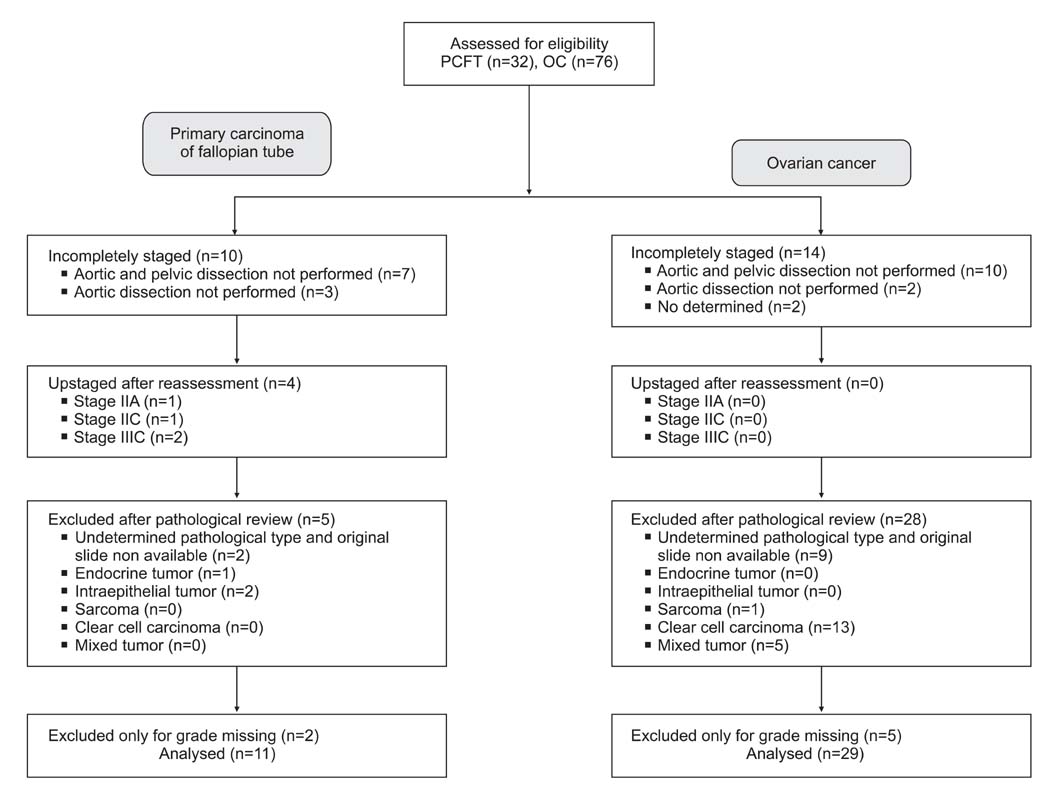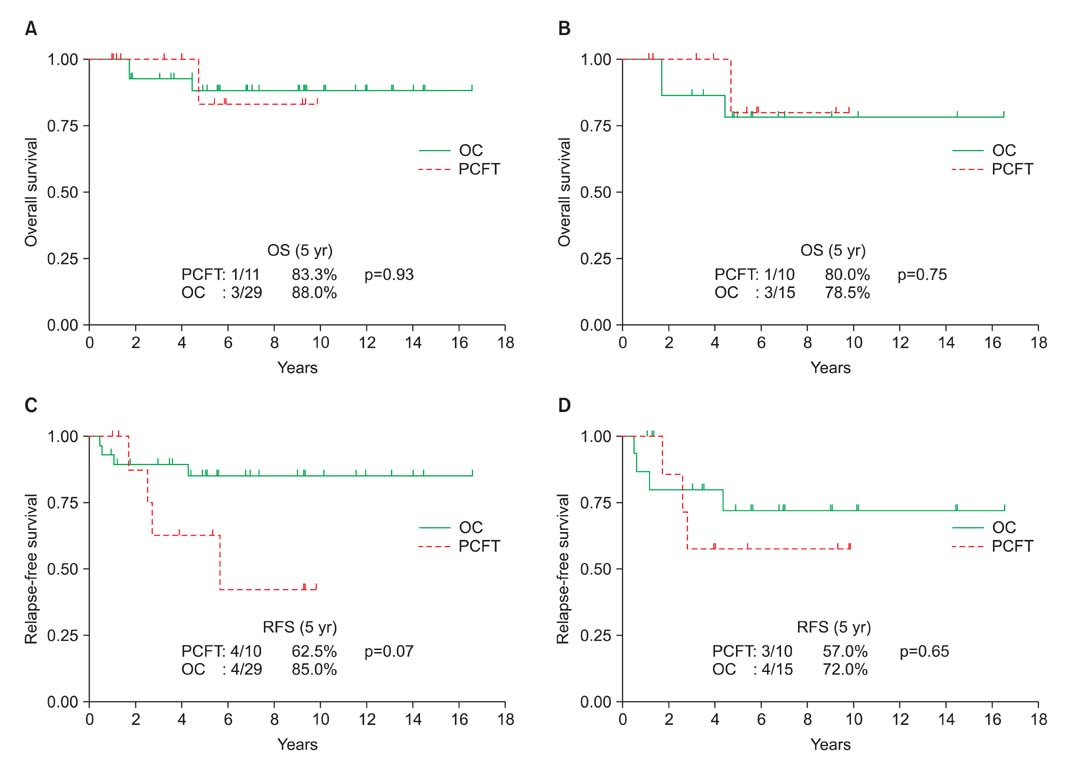J Gynecol Oncol.
2011 Mar;22(1):9-17. 10.3802/jgo.2011.22.1.9.
Early stage (IA-IB) primary carcinoma of the fallopian tube: case-control comparison to adenocarcinoma of the ovary
- Affiliations
-
- 1Department of Surgery, Institut Claudius Regaud, Toulouse, France. charlotte.vaysse@wanadoo.fr
- 2Department of Surgery, Institut Gustave Roussy, Villejuif, France.
- 3Department of Biostatistics, Institut Claudius Regaud, Toulouse, France.
- 4Department of Pathology, Institut Claudius Regaud, Toulouse, France.
- 5Department of Surgery, Centre Oscar Lambret, Lille, France.
- 6Department of Surgery, Hopital Rangueil, Toulouse, France.
- KMID: 2173580
- DOI: http://doi.org/10.3802/jgo.2011.22.1.9
Abstract
OBJECTIVE
Early stage primary carcinoma of the fallopian tube (PCFT) is an uncommon condition when strict criteria are applied. The aim of this study was to compare the outcome stage IA-IB PCFT to a matched group of ovarian cancer (OC).
METHODS
Between 1990 and 2008, 32 patients with stage IA-IB of PCFT were recorded in the database of three French Institutions. A control group of patients with OC was constituted.
RESULTS
Eleven eligible PCFT cases and 29 OC controls fulfilled the stringent inclusion criteria. Median follow-up was 70.2 months. Five-year overall survival was 83.3% (95% confidence interval [CI], 27.3 to 97.5) for PCFT and 88.0% (95% CI, 66.9 to 96.0) for OC (p=0.93). In the subgroup of patients with grade 2-3, the outcome was similar in PCFT compared to OC patients (p=0.75). Five-year relapse-free survival was respectively 62.5% (95% CI, 22.9 to 86.1) and 85.0% (95% CI, 64.6 to 94.2) in the PCFT and OC groups (p=0.07). In the subgroup of patients (grade 2-3), there was no difference between PCFT and OC (p=0.65).
CONCLUSION
The findings did not reveal any difference in prognosis between early stage of PCFT and OC when grade is taken into account. Management of PCFT should mirror that of ovarian carcinoma.
MeSH Terms
Figure
Reference
-
1. Nordin AJ. Primary carcinoma of the fallopian tube: a 20-year literature review. Obstet Gynecol Surv. 1994. 49:349–361.2. Trétarre B, Remontet L, Menegoz F, Mace-Lesec'h J, Grosclaude P, Buemi A, et al. Ovarian cancer: incidence and mortality in France. J Gynecol Obstet Biol Reprod (Paris). 2005. 34:154–161.3. Baekelandt M, Jorunn Nesbakken A, Kristensen GB, Trope CG, Abeler VM. Carcinoma of the fallopian tube. Cancer. 2000. 89:2076–2084.4. Moore KN, Moxley KM, Fader AN, Axtell AE, Rocconi RP, Abaid LN, et al. Serous fallopian tube carcinoma: a retrospective, multi-institutional case-control comparison to serous adenocarcinoma of the ovary. Gynecol Oncol. 2007. 107:398–403.5. Wethington SL, Herzog TJ, Seshan VE, Bansal N, Schiff PB, Burke WM, et al. Improved survival for fallopian tube cancer: a comparison of clinical characteristics and outcome for primary fallopian tube and ovarian cancer. Cancer. 2008. 113:3298–3306.6. Deffieux X, Morice P, Thoury A, Camatte S, Duvillard P, Castaigne D. Pelvic and para-aortic lymphatic involvement in tubal carcinoma: topography and surgical implications. Gynecol Obstet Fertil. 2005. 33:23–28.7. Tavassoli FA, Devilee P. Pathology and genetics of tumours of the breast and female genital organs (IARC WHO classification of tumours, No 4). 2003. Lyon: IARC Press.8. Pectasides D, Pectasides E, Economopoulos T. Fallopian tube carcinoma: a review. Oncologist. 2006. 11:902–912.9. Tamimi HK, Figge DC. Adenocarcinoma of the uterine tube: potential for lymph node metastases. Am J Obstet Gynecol. 1981. 141:132–137.10. Cormio G, Lissoni A, Maneo A, Marzola M, Gabriele A, Mangioni C. Lymph node involvement in primary carcinoma of the fallopian tube. Int J Gynecol Cancer. 1996. 6:405–409.11. di Re E, Grosso G, Raspagliesi F, Baiocchi G. Fallopian tube cancer: incidence and role of lymphatic spread. Gynecol Oncol. 1996. 62:199–202.12. Leblanc E, Querleu D, Narducci F, Occelli B, Papageorgiou T, Sonoda Y. Laparoscopic restaging of early stage invasive adnexal tumors: a 10-year experience. Gynecol Oncol. 2004. 94:624–629.13. Maxson WZ, Stehman FB, Ulbright TM, Sutton GP, Ehrlich CE. Primary carcinoma of the fallopian tube: evidence for activity of cisplatin combination therapy. Gynecol Oncol. 1987. 26:305–313.14. Muntz HG, Tarraza HM, Goff BA, Granai GO, Rice LW, Nikrui N, et al. Combination chemotherapy in advanced adenocarcinoma of the fallopian tube. Gynecol Oncol. 1991. 40:268–273.15. Morris M, Gershenson DM, Burke TW, Kavanagh JJ, Silva EG, Wharton JT. Treatment of fallopian tube carcinoma with cisplatin, doxorubicin, and cyclophosphamide. Obstet Gynecol. 1990. 76:1020–1024.16. Barakat RR, Rubin SC, Saigo PE, Lewis JL Jr, Jones WB, Curtin JP. Second-look laparotomy in carcinoma of the fallopian tube. Obstet Gynecol. 1993. 82:748–751.17. Peters WA 3rd, Andersen WA, Hopkins MP. Results of chemotherapy in advanced carcinoma of the fallopian tube. Cancer. 1989. 63:836–838.18. Pectasides D, Pectasides E, Papaxoinis G, Andreadis C, Papatsibas G, Fountzilas G, et al. Primary fallopian tube carcinoma: results of a retrospective analysis of 64 patients. Gynecol Oncol. 2009. 115:97–101.19. Roh MH, Kindelberger D, Crum CP. Serous tubal intraepithelial carcinoma and the dominant ovarian mass: clues to serous tumor origin? Am J Surg Pathol. 2009. 33:376–383.20. Jarboe EA, Folkins AK, Drapkin R, Ince TA, Agoston ES, Crum CP. Tubal and ovarian pathways to pelvic epithelial cancer: a pathological perspective. Histopathology. 2008. 53:127–138.21. Kindelberger DW, Lee Y, Miron A, Hirsch MS, Feltmate C, Medeiros F, et al. Intraepithelial carcinoma of the fimbria and pelvic serous carcinoma: evidence for a causal relationship. Am J Surg Pathol. 2007. 31:161–169.22. Carlson JW, Miron A, Jarboe EA, Parast MM, Hirsch MS, Lee Y, et al. Serous tubal intraepithelial carcinoma: its potential role in primary peritoneal serous carcinoma and serous cancer prevention. J Clin Oncol. 2008. 26:4160–4165.23. Crum CP, Drapkin R, Kindelberger D, Medeiros F, Miron A, Lee Y. Lessons from BRCA: the tubal fimbria emerges as an origin for pelvic serous cancer. Clin Med Res. 2007. 5:35–44.24. Semmel DR, Folkins AK, Hirsch MS, Nucci MR, Crum CP. Intercepting early pelvic serous carcinoma by routine pathological examination of the fimbria. Mod Pathol. 2009. 22:985–988.25. Deligdisch L, Penault-Llorca F, Schlosshauer P, Altchek A, Peiretti M, Nezhat F. Stage I ovarian carcinoma: different clinical pathologic patterns. Fertil Steril. 2007. 88:906–910.



